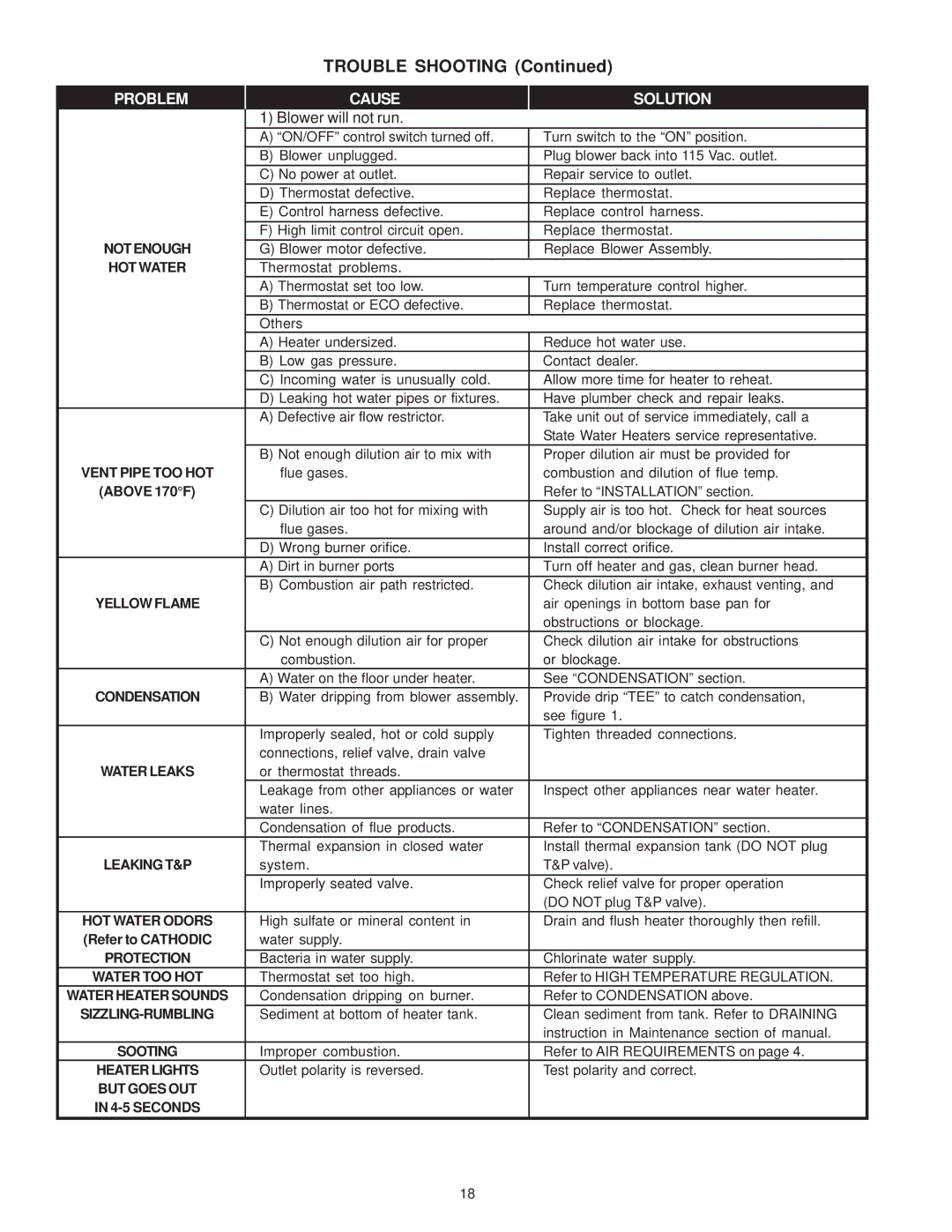TROUBLE SHOOTING (Continued)
PROBLEM | CAUSE | SOLUTION |
| 1) Blower will not run. |
|
| A) “ON/OFF” control switch turned off. | Turn switch to the “ON” position. |
| B) Blower unplugged. | Plug blower back into 115 Vac. outlet. |
| C) No power at outlet. | Repair service to outlet. |
| D) Thermostat defective. | Replace thermostat. |
| E) Control harness defective. | Replace control harness. |
| F) High limit control circuit open. | Replace thermostat. |
NOTENOUGH | G) Blower motor defective. | Replace Blower Assembly. |
HOT WATER | Thermostat problems. |
|
| A) Thermostat set too low. | Turn temperature control higher. |
| B) Thermostat or ECO defective. | Replace thermostat. |
| Others |
|
| A) Heater undersized. | Reduce hot water use. |
| B) Low gas pressure. | Contact dealer. |
| C) Incoming water is unusually cold. | Allow more time for heater to reheat. |
| D) Leaking hot water pipes or fixtures. | Have plumber check and repair leaks. |
| A) Defective air flow restrictor. | Take unit out of service immediately, call a |
|
| State Water Heaters service representative. |
| B) Not enough dilution air to mix with | Proper dilution air must be provided for |
VENT PIPE TOO HOT | flue gases. | combustion and dilution of flue temp. |
(ABOVE 170°F) |
| Refer to “INSTALLATION” section. |
| C) Dilution air too hot for mixing with | Supply air is too hot. Check for heat sources |
| flue gases. | around and/or blockage of dilution air intake. |
| D) Wrong burner orifice. | Install correct orifice. |
| A) Dirt in burner ports | Turn off heater and gas, clean burner head. |
| B) Combustion air path restricted. | Check dilution air intake, exhaust venting, and |
YELLOW FLAME |
| air openings in bottom base pan for |
|
| obstructions or blockage. |
| C) Not enough dilution air for proper | Check dilution air intake for obstructions |
| combustion. | or blockage. |
| A) Water on the floor under heater. | See “CONDENSATION” section. |
CONDENSATION | B) Water dripping from blower assembly. | Provide drip “TEE” to catch condensation, |
|
| see figure 1. |
| Improperly sealed, hot or cold supply | Tighten threaded connections. |
| connections, relief valve, drain valve |
|
WATER LEAKS | or thermostat threads. |
|
| Leakage from other appliances or water | Inspect other appliances near water heater. |
| water lines. |
|
| Condensation of flue products. | Refer to “CONDENSATION” section. |
| Thermal expansion in closed water | Install thermal expansion tank (DO NOT plug |
LEAKING T&P | system. | T&P valve). |
| Improperly seated valve. | Check relief valve for proper operation |
|
| (DO NOT plug T&P valve). |
HOT WATER ODORS | High sulfate or mineral content in | Drain and flush heater thoroughly then refill. |
(Refer to CATHODIC | water supply. |
|
PROTECTION | Bacteria in water supply. | Chlorinate water supply. |
WATER TOO HOT | Thermostat set too high. | Refer to HIGH TEMPERATURE REGULATION. |
WATER HEATER SOUNDS | Condensation dripping on burner. | Refer to CONDENSATION above. |
| Sediment at bottom of heater tank. | Clean sediment from tank. Refer to DRAINING |
|
| instruction in Maintenance section of manual. |
SOOTING | Improper combustion. | Refer to AIR REQUIREMENTS on page 4. |
HEATER LIGHTS | Outlet polarity is reversed. | Test polarity and correct. |
BUT GOES OUT |
|
|
IN |
|
|
18
